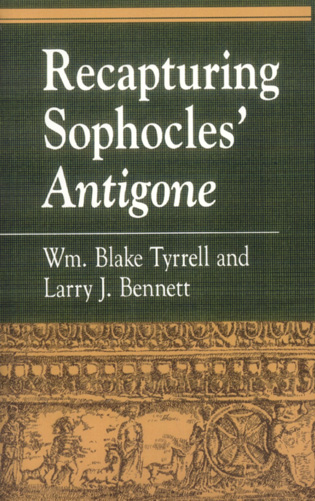Greek Studies: Interdisciplinary Approaches
Foreword by Gregory Nagy, General Editor
 Recapturing Sophocles’ Antigone, by Larry Joe Bennett and William Blake Tyrrell, approaches the Antigone of Sophocles by concentrating on the historical context of audience reception. From this point of view, they force a reassessment of the basic question: what is this play about? According to Bennett and Tyrrell, the Antigone is not about burying a corpse, as has been the focus of much modern criticism. Rather, it is about Antigone’s actions on behalf of the body of her brother, Polyneices. The audience needs to know: who controls the corpse of Polyneices? Is it the family or the State, that is, the Demos?
Recapturing Sophocles’ Antigone, by Larry Joe Bennett and William Blake Tyrrell, approaches the Antigone of Sophocles by concentrating on the historical context of audience reception. From this point of view, they force a reassessment of the basic question: what is this play about? According to Bennett and Tyrrell, the Antigone is not about burying a corpse, as has been the focus of much modern criticism. Rather, it is about Antigone’s actions on behalf of the body of her brother, Polyneices. The audience needs to know: who controls the corpse of Polyneices? Is it the family or the State, that is, the Demos?
Sophocles’s play explores the institution of the “state funeral” and its intrusion on the traditional rights of women to care for the dead of their families. The wording used by Sophocles evokes the conventions of the public funeral oration, delivered by statesmen over the bodies of those who died for the State. The dialogue between Antigone and Ismene and the kommos of Antigone and the Coryphaeus are especially pertinent.
The rituals of funeral intersect with those of marriage, and these intersections deepen the tragedy. By corrupting funeral rites and exposing the corpse of Polyneices, Creon allows the pollution to spread. With the loss of ritual purity comes the loss of fertility. The deaths of the bride and groom lead to the destruction of the house. Furthermore, the Antigone reproduces for the tragic stage the myth of the Theban dead, which was not only part of the orator’s repertoire of myths but also belonged to an overall mythical armature that casts Thebes as an “anti-Athens” (in the words of Froma Zeitlin). In Athenian “state myth,” Thebes represents the opposite of Athens, as here highlighted by the roles of Creon, Ismene, and even Antigone.
Creon as a Theban leader is impious for denying burial from the outset. Athenians, by opposition, are surely “civilized”: they bury their dead. As an anti-Athenian, Creon could only expose the corpse or give it its last rites improperly. Bennett and Tyrrell contrast this perspective with modern critical views of tragedy and the tragic hero, featuring Creon as the good man who tragically turns into a tyrant.
Similarly, Ismene is not the foil for Antigone that modern readers have created. She refuses to oppose a painful decree of the State against tending her brother’s corpse, but she willingly offers herself to die for her near-and-dear ones, and she defends the marriage of Antigone and Haemon. All of these stances are desirable attributes in the women of the Athenians who are the audience. The headstrong Antigone who is bent on a single deed—to heap a mound over her brother’s corpse or, failing that, to give it a symbolic dusting—is a modern invention, according to Bennett and Tyrrell. No Athenian would admire a woman who competed with him for aretē and caused him such shame by not acting in accord with his instructions.
This book places the Antigone in the context of fifth-century Athens, returning the play to the way it was received by an audience of contemporary Athenians. It allows the play to set its own agenda. It is not a commentary, nor do the authors engage the innumerable polemics occasioned by modern interpretations. Notably, the book interprets the events at Polyneices’ grave by referring primarily to the Homeric treatment of the theme of the exposed corpse, not to the question of a “double burial,” which derives from a formulation devised by Jebb on line 423 of his commentary. The latter question—as well as other questions—will not go away because of this book, but the hope remains that still other questions, especially those that were demonstrably essential to fifth-century Athenians, will have their day in the sun. This book raises precisely those kinds of questions.
—Gregory Nagy
Building on the foundations of scholarship within the disciplines of philology, philosophy, history, and archaeology, the Greek Studies: Interdisciplinary Approaches series published by Rowman & Littlefield concerns not just the archaic and classical periods of Greek traditions but the whole continuum—along with all the discontinuities—from the second millennium BCE to the present. The aim is to enhance perspectives by applying various disciplines to problems that have in the past been treated as the exclusive concern of a single given discipline. Besides the crossing-over of the older disciplines, as in the case of historical and literary studies, the series encourages the application of such newer ones as linguistics, sociology, anthropology, and comparative literature. It also encourages encounters with current trends in methodology, especially in the realm of literary theory.
The Center for Hellenic Studies offers free access to over 100 books and articles. Visit the CHS website and browse our publications for an extended list of book titles on the Classical world and ancient Greek literature.
